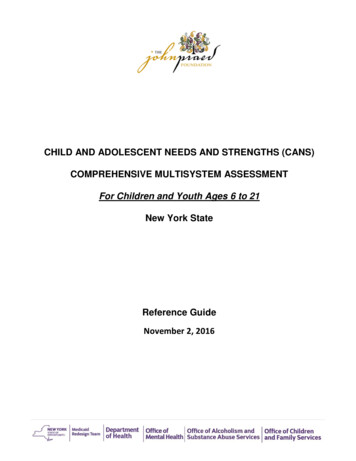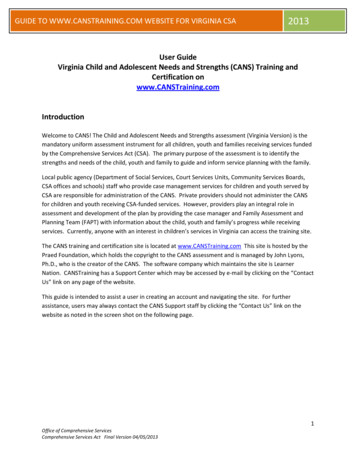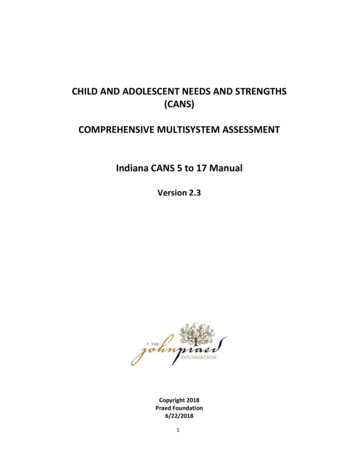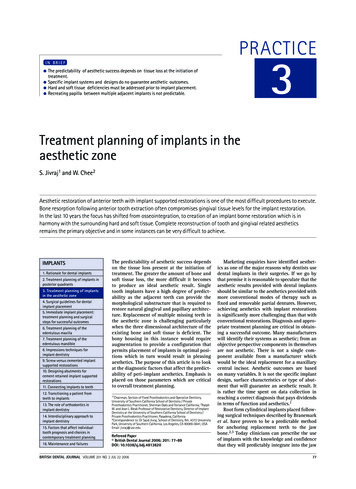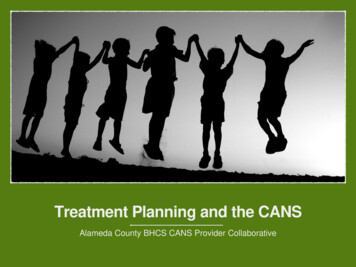
Transcription
Treatment Planning and the CANSAlameda County BHCS CANS Provider Collaborative
Developing a shared vision—a shared understanding ofthe problems and how theycame about, shared goalsand a set of actions toachieve those goals– is keyto any change happening.
MOVING FROM THE ASSESSMENT* Review and confirm needs and strengths* Identify PrioritiesIDENTIFYING THE WHY* Case conceptualization* Background, Target, Outcome NeedsTREATMENT PLAN* Create goals and objectives* Monitor Progress, check back with familyCOLLABORATION
Moving from theassessment .
Moving from the assessmentReview and identify actionable needs andstrengthsWhat are the priorities?Identified together, building consensus
Your Turn!Take the CANS Items from the Mike Vignette andreview needs and strengths and identify priorities
Identifying the Why: CaseConceptualization
Case ConceptualizationA description of what’s going on with the client and why.Based on what the client and family tell you through the completion of a bio-psycho-socialassessment.A co-constructed story with the client/family/others. This is a collaborative endeavor,incorporating client views and beliefs. It is not imposed on the client and caregiverOrganized/informed by theory and your past clinical experience and knowledge.When shared with client/caregiver, it canFacilitate the development of rapportFunction as a intervention especially in gaining understanding, developing empathyServe as the basis for additional interventionsPromote transparency in the treatment
Conceptualizing a case(building blocks of a formulation)symptoms & problemsprecipitating stressorspredisposing eventsstrengths & assets
Theory & ConceptualizingBehaviorallearning historycontingencies of reinforcementstimulus-response e thoughts/beliefsabout the self/others/world/futureSystemicunconscious process and conflictsmaladaptive patterns in relationshipproblem-maintaining patterns, feedback loops,beliefs and expectations in the family(NOTE: According to a July 2015 article in the Psychotherapy Networker, there are more than 400 approaches toconducting psychotherapy, including 145 “manualized, evidenced –based treatments”!!).
Integrating Case Conceptualization and theCANSCANS items can be thought of in the following way:BACKGROUND: historical/developmental items whichwon’t change but may significantly contribute to currentsymptoms and functioningTARGET: items that are changeable and are usually thefocus of treatment interventionsFUNCTIONAL OUTCOME: changes in targeted items thatpromote changes in functioning
BackgroundTreatment TargetAnticipatedOutcomeDevelopmental MilestonesBehavioral/ EmotionalNeedsLife FunctioningTrauma ExposuresTrauma SymptomsRisk Behaviors
AnticipatedBackgroundTreatment TargetDevelopmental MilestonesRisk BehaviorsLife FunctioningTrauma ExposuresTrauma SymptomsBehavioral/ EmotionalNeedsOutcome
Your Turn!Take the actionable items from the Mike Vignetteand place them into the different buckets(background, target, and outcome).
Treatment Planning
Writing Treatment PlansUse of CANS items in treatment plans:Items rated 2 or 3 that are related to symptoms and/orfunctioning should be addressed in the treatment plan.Numerous items rated 2 or 3 are prioritizedaccording to risk or magnitude of impact on clientTreatment team and/or family may choose to holdoff on certain needs.Cluster or group items togetherStrengths are utilized in the Treatment Plan
Reminders aboutTreatment PlansTreatment plans are based on a Case ConceptualizationTreatment Plans address:Presenting problems/concerns of the client/caregiverDiagnosis and symptomsClient language should be usedGoals and objectives are clearly written to identify when they havebeen achievedSpecific, measurable, and/or observableObjectives should be achievable within 3-6 monthsWhen Goals are met, treatment is complete
Goals and ObjectivesBy definition, goals and objectives are oftensynonymousFor the purpose of writing a treatment plan, goalsand objectives are defined and differentiated asfollows:Goals are general statements of what a clientwants to accomplishObjectives are the specific steps along the wayto achieving the overall goal
GoalsGeneral statements of what a client/family wants toaccomplishGoals are usually improved functioning and/orreduction of symptomsWhen goals are met, treatment concludesAt least one CANS item can be used as a way ofmeasuring whether a goal has been met
ObjectivesObjectives are the specific steps to achieving the goalOften described as “What the client is going to do?”Objectives are measured by CANS items, are specific,measurable, or observable so it is clear when they have beenmetThe timeframe for meeting objectives is between 3-6 monthsNot meeting objectives leads to a tx plan review. New orrevised objectives may be needed.Meeting objectives leads to achieving goals
SMART ObjectivesObjectives are SMARTSpecific (What the client is going to do)Measurable (numeric or descriptive, quantity or quality)Achievable/Attainable (feasible, realistic)Results-Oriented (the patient will demonstrate, see,develop, etc.)Timely (target dates, use of incremental steps to measureor monitor progress)
Putting it together:Examples
Actionable Items: TraceyAdjustment to Trauma2Family3Affective/Phys. Dysregulation3Living Situation3Traumatic Grief3School3Depression2Community away3Knowledge2Judgment3Safety2Sexual Exploitation3
Conceptualization: TraceyFor Tracey and her Moms:We need to keep Tracey safe and not run away from home. She can’t deal with thestructure and expectations at home and is always in arguing and fighting with the family.Tracey is not engaged in age appropriate activities, including going to school. Moms areconcerned that Tracey will run back to the streets and get raped or killed.Problems are linked her difficulty in trusting her parents, as they have let her down in thepast (not protected her or cared for her).Tracey was on AWOL and on the streets when her father died. She feels it was her faultfor not being there to protect him. She has not grieved his loss.The traumas that Tracey has experienced—sexual abuse as a child, sexual exploitationcurrently—are impacting her ability to function, including staying safe.
From Conceptualization to CANSTraumatic GriefAff/Phys DysregTreatment Target?AnticipatedOutcome?Sexual AbuseSexual ExploitationFamily FunctioningRunaway
Conceptualizing NeedsThe case conceptualization helps identify the Background needs, and sort out the Treatment Targetneeds from the Anticipated Outcomes needs.Sexual Abuse ExploitationBackground Needs Traumatic GriefAff/Phys DysregTreatment TargetFamily FunctioningRunawayAnticipated OutcomeWithin the context of complex trauma, interventions will focus on addressing Tracey’s grief around her father’ssuicide and the dysregulation she experiences (Treatment Target Needs) that underlies her difficulties at homeand desire to run. If treatment is effective, her functioning within the family will improve and her instances ofrunning away will decrease (Anticipated Outcome needs).
BackgroundTreatment TargetTrauma ExposuresTrauma SymptomsSexual Abuse———————ExploitationTraumatic alDysregulationAnticipatedOutcomeLife FunctioningFamily Functioning———————Runaway
BackgroundSexual t TargetTraumatic alDysregulationOutcomeFamily CANS Item/RatingOur family needs to get along better. Moms need to find ways to bettersupport Tracy.Family Functioning 3 to 2Involvement in Care 1 (STR)1. Tracey and her moms will be able to identify at least two signs andsymptoms of dystreguation.Objective2. Tracey and her Moms will be able to identify three triggers forTracy’s siologicalDysregulation 3 to 2Knowledge 2 to 1Through individual therapy and family sessions, provide psychoeducation to Tracey and her Moms on theimpact of the abuse and exploitation on her coping/dysregulation and how she deals with stress at home.
Treatment planning: AnthonyAnger Control2Educational2Anxiety2Well Being2Adjustment to Trauma2Optimism2Family Functioning2Community Life2School2Danger to Others2Witness to Community Violence3
Conceptualization: AnthonyAnthony witnessed his friend getting murdered andthis led to traumatic stress symptoms includingsignificant anger and anxiety. These traumatic stresssymptoms have led to problems in school and withpeers.
BackgroundTreatment TargetWitness to CommunityViolenceAnxietyAnger ControlDescriptionGoalObjectiveWe want Anthony to do better in school.1. Anthony will use relaxation techniques including progressive musclerelaxation to during episodes of anger and anxiety (1 out of every 2times), per client report.AnticipatedOutcomeSchoolCANS Item/RatingSchool 2 to 1Anxiety 2 to 1Anger Control 2 to 12. Anthony will identify at least two cues that trigger trauma-relatedanger or anxiety.InterventionThrough individual therapy and psychoeducation to Anthony on the impact of the violence he witnessedon her coping/dysregulation and how she deals with stress at home.
Treatment planning:NickPeer/Social Experiences3Sexually Inappropriate Behavior2Knowledge of Illness2Self-Care2Intimate Relations2Talents and Interests3Impulse Control2Resiliency3Substance Use2Service Permanence0Job Functioning3Relationship Permanence1Sanction Seeking Behavior2Resourcefulness1
BackgroundDevelopmental(Cognitive Disability)Treatment TargetSubstance Use------------------Self CareDescriptionGoalNick will meet and have more positive experiences with friends andpeers.1. Nick will maintain sobriety for 90 daysObjectiveIntervention2. Nick will develop and stick to a routine that includes showering,brushing his teeth and shaving at least 3x per week.AnticipatedOutcomePeer/Social ExperiencesCANS Item/RatingPeer/social experiences 2 to 1Substance use 2 to 1Self Care 2 to 1Strengths to Support:Relationship Permanence 1Resourcefulness 1The treatment team will identify NA meetings that Nick can attend and will help Nick find a sponsor. Thetreatment team will also support Nick in attending a 10 week workshop on independent living skills andwill match Nick with a peer counselor to provide support and feedback.
Your Turn!(putting it all together)Review Mike Vignette, needs, strengths andprioritiesReview Case ConceptualizationReview Background, Target and Outcome NeedsDevelop Treatment Goals and Objectives
What Youth SayFocus on the present, not thepast (focus on the now)Give me new ways to cope withdifficult feelings (be concrete)When something I’m trying isn’tworking, give me a new behaviorto try (be flexible)Help me stay out of trouble andbecome successful by connectingme with the things that I want todo and become (be strengthsbased)
And from CaregiversTreatment plans should be in thelanguage with which we’re mostcomfortable.Goals in my words; if the goalhas been written, I should beable to state it back to you in mywords.I may need a day to look over thegoals, talk them over withsomeone I trust before I sign offon them.Don’t talk to us in one way, andthen talk about us in another.
Goals and Objectives By definition, goals and objectives are often synonymous For the purpose of writing a treatment plan, goals and objectives are defined and differentiated as follows: Goals are general statements of what a client wants to accomplish Objectives are the specific steps along the way to achieving the overall goal


